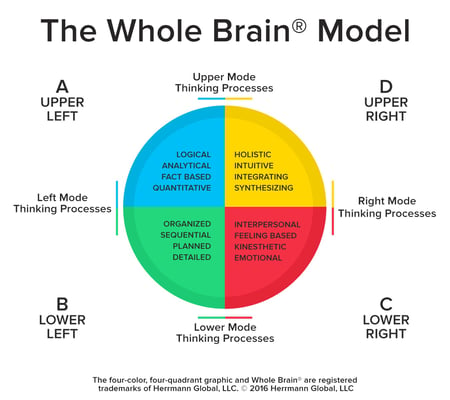 In my last post, I discussed the communication problems that arise when a person who thinks one way speaks to a listener who thinks in a completely different way. The person doing the talking is presenting the kind of information that is important to him, but he doesn’t get his message across because what’s important to his listener is something entirely different.
In my last post, I discussed the communication problems that arise when a person who thinks one way speaks to a listener who thinks in a completely different way. The person doing the talking is presenting the kind of information that is important to him, but he doesn’t get his message across because what’s important to his listener is something entirely different.
I also talked about how incorporating Whole Brain® Thinking into your sales process helps you identify how your prospects think so you can present the information your prospects need to hear to say, “I’ll buy!” Now, I’d like to share some examples of how people and companies I know have used this information to increase sales, repair dysfunctional teams, and improve (or even save) personal relationships.
Real world outcomes
1. Saving a stalled sale
Here is one of my own stories of how I saved a sale with Whole Brain® Thinking. After teaching a training workshop to a restaurant equipment company, I wanted to work with them on a deeper level by helping them redesign their sales strategy and teaching them how to execute it. The owners wanted to talk about it and asked me what the next step was.I tried to discuss ideas and share what was needed from a right brain perspective – my perspective – which is about relationships and futuristic vision. But the owners are very analytical and wanted data, so what I proposed did not make sense to them.
To illustrate what I wanted to do and why, I developed a spreadsheet showing sales quotas, activity levels, meetings needed, proposals given, and closes required to reach quota. I explained that each ratio had a specific behavior or skill that is needed to deliver the desired result, and I was proposing to teach those skills.
Once they saw my proposal from a numerical perspective, they totally understood what I was proposing and why, and they bought whole-heartedly.
2. Complex sales with multiple buyers and influencers
I once worked with a physical therapy clinic who had hired several ace sales reps, but none had been successful in calling on physicians and nurses. We thought we would do something different by making a physical therapist a part-time sales rep. I profiled the chosen therapist and found that she was very high B and C, and moderate D. She had a low preference in the A quadrant.
Her target referral sources, however, were orthopedic physicians who are very strong in the A (facts) and D (big picture) quadrants. She was also going to have to work with a couple of influencers without whom she couldn’t even gain access to the doctors to make her pitch. The office manager was typically moderate A, high B, and high C. The nurse scheduler was high in B and C. We developed her sales call around all those thinking preferences to approach each individual in different ways.
Since the office manager was concerned with the smooth running of the clinic, the sales rep focused on setting appointments on a consistent basis, and not just “popping in” to see if the doctor could spare a moment. As she worked with the nurse scheduler, the focus was to be pleasant and “not screw up her day” by interrupting her routine. Using these strategies, she found it relatively easy to get in front of the decision-makers.
As a physical therapist, she approached the doctors from a clinical perspective, discussing facts about their clinic and treatment plans. She asked them what their biggest complaints were in dealing with physical therapy clinics and found out they didn’t like the fact that clinics left them uninformed on their patients’ progress. She committed to personally delivering patient report charts to the doctors, and they loved it.
With these sales tactics in place, referrals doubled in 45 days and were up 150% in eight months. Two years later, total referrals were up 230%.
3. Fixing dysfunctional teams
I once profiled an entire sales department: the sales team, their vice president, director, and eight sales managers. It analyzed their results to understand how the group made decisions. Even though their jobs were very people-oriented, their preferred quadrants were facts, processes, and ideas (A, B, D). The C quadrant was not as important to them, and it showed that communication with their team was a low priority. Do you see potential problems with this team?After I profiled them, the Senior VP recognized why one of their initiatives was six months behind. They had failed to communicate with users and the lower echelon of reps. The sales managers used the information they learned from each person’s profile and from the team’s profile on the Herrmann Brain Dominance Instrument® to re-prioritize communication and improve coaching their reps and writing proposals.
4. The power of understanding your own brain
Because of its power to improve communication and understanding between people, Whole Brain® Thinking is more than just an essential tool in the sales discussion. It is useful in any setting or application; from strategic planning and problem solving to designing web pages, writing proposals or job descriptions, and even personal relationships. My wife tells people that learning one another’s thinking preferences and communicating with them in mind literally saved our marriage!Many people who take this training say it has changed their personal lives as much as it has their sales. Here’s a powerful testimonial from a student in one of my recent classes:
“The return on investment for Bill’s Whole Brain® teaching is literally INCALCULABLE. I wanted to learn how to understand my clients better, which I did, but I was shocked at how much I learned about myself; and to realize that this self-knowledge is just as valuable as the knowledge I gained of others.
Bill’s teaching obliterated some ill-conceived notions and limiting beliefs about myself that were holding me back. I emerged with a confidence I’ve never had before and a million ideas about how to apply what I’ve learned in dealing with clients, prospects, and even friends and family. There is no area of life in which this information does not have game-changing applications. And the value will just keep growing exponentially through the years the more I make this teaching part of how I operate and how I sell my services.” -Rachael Hodo, ProAdmin Solutions LLC
When I asked permission to share this quote, Rachael also wanted to let people know that I did not solicit this testimonial. She posted this on LinkedIn the day after the class finished simply because she was so excited about the personal insights she had gained and how they empowered her. She tells me she is still reaping the benefits every day!
There are many other success stories like this from people all over the world who have used this system to be better at everything they do. 99% of Fortune 100 companies use it to outperform the competition in every area. If you’d like to see what it can do for your or your organization or team, contact me at bill@billhartbizgrowth.com or see my events page for upcoming workshops.

